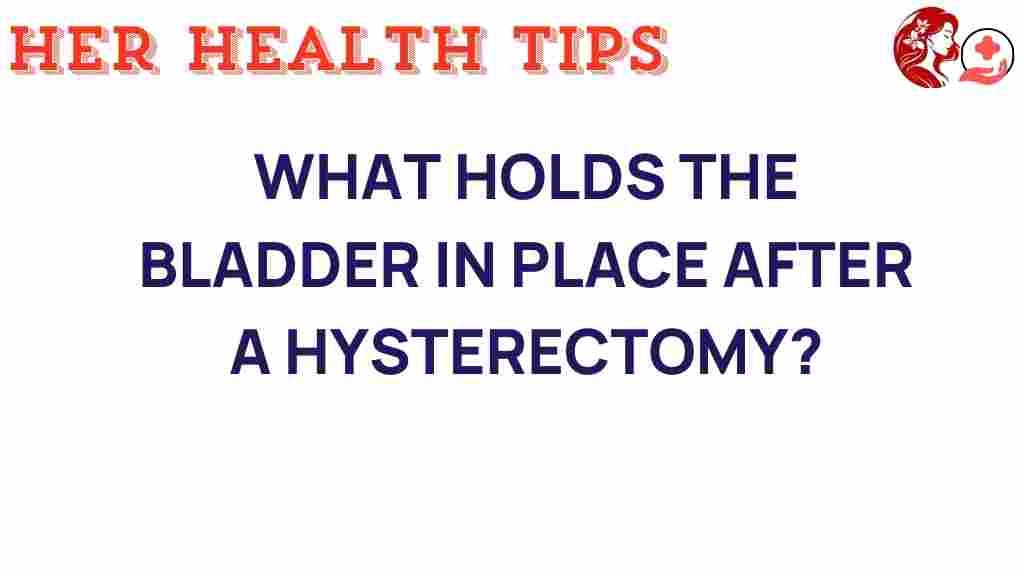The Hidden Mechanics: What Supports the Bladder Post-Hysterectomy?
Undergoing a hysterectomy is a significant event in a woman’s life, often necessary for treating various conditions such as fibroids, endometriosis, or cancer. While it can alleviate many health issues, it also brings about changes in pelvic health and bladder support that require attention during recovery. Understanding the anatomy and the effects of surgery on bladder function can help women manage their post-operative care effectively.
Understanding Bladder Support and Anatomy
The bladder is a muscular sac that stores urine, located in the lower abdomen. It is supported by several anatomical structures, including:
- Pelvic Floor Muscles: These muscles form a supportive hammock-like structure at the base of the pelvis.
- Fascia: Connective tissue that supports pelvic organs.
- Ligaments: Connect the bladder to surrounding structures, providing stability.
After a hysterectomy, the removal of the uterus can disrupt these supportive structures, which may lead to issues such as urinary incontinence or pelvic organ prolapse. Understanding these changes is crucial for effective recovery and maintaining bladder support.
Types of Hysterectomy and Their Effects on Bladder Support
There are different types of hysterectomy procedures, and each can have varying impacts on pelvic health:
- Total Hysterectomy: Involves the removal of the uterus and cervix, which may affect the pelvic floor muscles.
- Subtotal (or Partial) Hysterectomy: The uterus is removed but the cervix is left intact, potentially preserving some pelvic support.
- Radical Hysterectomy: Involves the removal of the uterus, cervix, surrounding tissues, and often parts of the vagina, significantly impacting pelvic health.
Post-operative recovery can vary based on the type of surgery performed and individual anatomical differences. Understanding these surgical effects is crucial for women to anticipate their recovery needs.
Post-Operative Care for Bladder Support
Recovery after a hysterectomy requires focused attention on pelvic health. Here are key steps to ensure optimal bladder support during this phase:
1. Follow Medical Advice
Your healthcare provider will offer specific recommendations tailored to your recovery. Adhere to these guidelines closely to ensure a smooth recovery process.
2. Engage in Pelvic Floor Exercises
Pelvic floor exercises, commonly known as Kegel exercises, can strengthen the muscles that support the bladder. Here’s how to perform them:
- Identify the Right Muscles: Stop urination midstream to locate your pelvic floor muscles.
- Exercise: Contract these muscles for 5 seconds, then relax for 5 seconds. Gradually increase to 10 seconds.
- Repetition: Aim for three sets of 10 repetitions daily.
3. Stay Hydrated
Drinking enough water is essential for bladder health. However, avoid excessive caffeine and alcohol, which can irritate the bladder.
4. Manage Weight
Excess weight can put pressure on the pelvic floor, exacerbating bladder support issues. A balanced diet and regular, gentle exercise can help manage weight during recovery.
5. Maintain Regular Bowel Habits
Constipation can increase pressure on the bladder. Include fiber-rich foods in your diet and stay hydrated to maintain regular bowel movements.
Common Post-Hysterectomy Bladder Issues
While every woman’s recovery is unique, some common bladder issues can arise after a hysterectomy:
- Urinary Incontinence: The involuntary leakage of urine can occur due to weakened pelvic support.
- Overactive Bladder: A sudden urge to urinate that may lead to frequent bathroom trips.
- Difficulty Emptying Bladder: Some women may experience challenges in fully emptying their bladders post-surgery.
Troubleshooting Tips for Bladder Support
If you experience bladder issues after a hysterectomy, consider the following troubleshooting tips:
1. Consult a Pelvic Floor Specialist
If bladder problems persist, consider seeking help from a pelvic floor specialist. They can provide tailored exercises and therapies to improve bladder support.
2. Use Bladder Training Techniques
Bladder training can help regain control over urination patterns. This involves gradually increasing the time between bathroom visits to retrain the bladder.
3. Medication Options
In some cases, medications may be prescribed to help manage overactive bladder or other urinary symptoms. Discuss these options with your healthcare provider.
4. Lifestyle Adjustments
Making lifestyle changes, such as adjusting your diet or exercise routine, can significantly impact bladder health and support.
Long-Term Considerations for Pelvic Health
Maintaining bladder support and overall pelvic health is an ongoing process. Here are some long-term considerations:
- Continued Exercise: Regular pelvic floor exercises and overall fitness can help maintain strength and support.
- Routine Check-Ups: Schedule regular visits with your healthcare provider to monitor pelvic health and address any concerns.
- Education: Educate yourself about pelvic health and bladder support through reliable resources or support groups.
Conclusion
Understanding the hidden mechanics of bladder support post-hysterectomy is vital for managing recovery and maintaining long-term pelvic health. By following medical advice, engaging in pelvic floor exercises, and being proactive about potential bladder issues, women can navigate the challenges that may arise after surgery. Remember, every woman’s experience is unique, so staying informed and connected with healthcare professionals is key to ensuring optimal recovery and health.
For more information on women’s health and pelvic support, consider visiting this resource. You can also explore personal stories and additional support at here.
This article is in the category Reproductive and created by HerHealthTips Team
